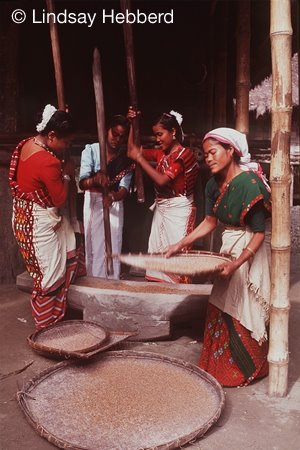Leke:lo sumnyo dornyi: ko koje pa:ta ru:yido dungngai.Binyi: apta atí légapé mé:pénamé kamangai.Simín-sirrém pa:ram mangngai.Édémpila bínyi: koje pa:tangém mépakla okolopésin gímangai.Bínyi:kké ame: ame:né ao: dornyikosin dungngai.Ao: kídardé aíé símín matasula dokin mangngada.Édémpila abodé apta gímílo anédé ao: kídardém ka:si: dungngai.
Édé pa:tang kérangké bogum sí:ludo Mensarung adorkosin dungngai.Édé mensaru:dé aipé tengor kanékai.Bikké ao: ommang okkosin kamangai.Bik aíké aki:dok légapé ami ké doruk dopugo:ngngém magola yedungai.
Longékolo mensaru:dé anínké tani: do:lungkolo dopuk dongadém dogongkapé gíla yaggola du:dom tani: íra:dok yuppakla lé:nam bedné du:n kolo pítkepsuto.Du:ndé bíkké línggu:do kíp-kappé pítkepkang.Kapésin pítyuk-sula:tokumang. Apta atíé du:ndok aduddém tadbegmílloi dupagdakku.Odokké do:lu:lo:gom du:ndok bé:namém tadbekmílloi amme: méndak.Édémpila donam tí:nam pangku:ma:la longngém longépé sanpé sana:bomkang.
Longkolo abo sumnyodé aptapé gikang.Édé agomdém mensaru:dé kinna sumnyo anédo:pé gía:la lukang-“Éi,sumny né:ng,nokké milbongé okolopé gíkan? no kindon, nokké milbongé sé ngokké du:nsokki du:nko murkongém nartung.Lomna biyem bigortéiku.Ékéma:mílo nok sé ao: anyi:sok adorko bikupé lagiye.Déma:mílo agomé aimaye.Kindon?Sé koje pa:tasokké nolu gípakkupé lagiye.Sé ngokké ta:to yo:yoké kojebé:dam amo:ngé.So ngokké agomo:lok yeladak.”Mensaru:dok agomdém talla sumnyo ané péso kokki yessé len-go:sukang.Bí ao: kídardok légapé pésoki lukang-“Migoma,atí atídém man-goyobongka. Sé dumsung adín asutko du:ng sém bomna gípongkakubong.Bí gíangkumílo agomdém lumínsulangkupébong.”Édémpé lugelam sumnyo anédé Dumsung adín asutko bitoku.Odo Mensaru:dé aipé aséla bomna gíkangku.Édémípé bí lo:dípé sumnyo anédém morítla adíném bomdakku.
Longékolo do:ying appídém sumnyo abo dém lubitoku.Odo édé longédo sumnyo abo dé séuko ito.Ané sumnyodém ayat yaddopé luto odokké bí sumken kolo aso:pé lé:sila dungkang.Angu longé kídardémpé édé longédo:sin Mensaru:dé morít mokela gía dungngai.Odo Sumnyo abo dé gampé émna sumgaptagai.Mensaru:dé daddo:pé sumpítsuto.Sumnyo abo dé mensaru:dém ménbomkang.Ménbomna gídolo ké:né amíngko ge:setsula dungngai.Édé ké:né amídok porkebdokki Mensaru:dé déngkolola gíkang.Sumnyo abo dé sumkepsula dungkang.Mensaru:dé bérkutsula ka:namé sumnyodé dugmínmang.Émpila gílatsula ka:ngkapé gílattoku.Ka:namé ké:né amído pítkepsula dag.Taying kídardé uying émna dé:pansukang.Édém tatla ya,émna pésoki mensaru:dé lomgésula bérkutsumapé dukkang.Asutko duggela gílatsula ka:namé sila dag.Odo Mensaru:dé asin bottapé mosula Sumnyo anédo:pé gíla lukang-“Éi ,sumnyo né:ng,nokké milbongém ngo ké:né amíngélé oksilge:la paksa:la métak.Ayatpé mé:dakmílo gíla ka:toka.Supak no ngokké né:pé gíyén gíma:n?lutok.Ékémamílo ador adorpé nok ao: dornyi: sém mokeyamye.”Sumnyo anédé ao: dornyi:dok légapé Mensaru:dok lukam lukampéi tatto.Mensaru:dé sumnyo né:dém morít moke:la migomémpé okumo:do du:la dodag.Sumnyo anédé apta gíla dobodag.
Longékolo sumnyo anédé lukang-“Éi,sé si:lu:sé apta atíé kakuma:pé idung.Ngolu angu sí:lu:pé gípé lagiye.”Édémdémpé lula Sumnyo anédé sí:lu:ng angukolo:pé gíboto.Lamtédo bottan asi korongko pa:la ba:ngkopé ito.Odo Sumnyo anédé ao: anyi:dém gordungdo jo:líksuge:la a:né:dém ba:ngkoto.Odokké Mensaru:dé asi siyaddo ji:bu:rutkang.Ngakí ngakíla asi bojeko tí:la ba:butsukang.Odo Sumnyo anédé ao: dornyi:dém tayo:do mégela Mensaru:dém soríksutoku.Témpído mensaru:dé botta bottapé jé:la lukang-“no kapila ngom sosangkaku:n?ngo asisé íddíko o:rí:dakson émnamín síngka:dunga:n.”Édémpé lugela tang émdopé Sumnyo anédém pipaklíkto.Aipé morítmoke daggom Sumnyo anédé ao:kídardok légapé Mensaru:dé kapéi luyeji édémpéi talla yebosula dungkang.
Longékolo appípagdé lékopé kiruk rugbosukapé gíto.Mensaru:dém símín ménnígdopé mílíkto. Símín kídardé mensaru:dém péssoika:mang.Édémpila Mensaru:dém símín togabdopé mílíkto. Odokké ao: ané kídardé símín kídardém mén-yet mén-yella ménlíkto. Mensaru:dé yenggappé émna símín adorko sumgapto.Símíndé mensaru:dok aki:dém baddanna batsurlíkto.Odo Mensaru:dé aki: gomgapsula sia:la dungkang.Sumnyo anédé tauto-“kapila símíném adorkosin gamtoma:n?”odo Mensarudé lukang-“ame ame:ya:uné símín kídardém ka:la yirkolok ngok aki:ém yirsursuto.Odo sumnyo anédé:lang ao: kídardé lékola angupé kirugém rukla Dumsung adorko pa:to.Édém bulu orsula doto.
Édé bogum sí:lu:do bojeko Mensaru:ngé dungngai.Yumé ayirém Mensaru:ng kídídé lo:dípé utak uyaksudag.Édém Mensaru:dé talla yumé ayirdé lo:dípé lé:si:la umín kapé gídak.
Longé gítíkang.Sumnyo ao: dornyi:dégom botta:usangkabong.Bínyi:sin aíké yelam kumli:ém kinsusangka:bong.Ngoluké ba:bu bí yumdípé yumrang ara:ngo:lo okkom ikapé gídon émna anédém tauto.Anédé odo atímang,Sisi mokapé gídag émna lubidag.Ao: anyi:dé anédok agom dém aropé mé:ma:la bínyi: abudok me:lam me:lamdo rubbomkang.Yuméko:lo ka:namé Mensaru:ng asumdo gía:mínna uke uye émna umínnadung.Odo bulu kinto ngoluké abumang émna.Sé Mensaru:ngé.Odo anédém gia:langkula tautoku.Odo anédé lukang-“arro. Noluké abuém bí:íng moketo.Odo nolu ajja:udagai.Nolum o:sa:nam légapé ngo bíkké luko lukol talla nolum síddíko bottado:pé o:sa:to.Supak nolu botta:utoném ngokké asinsé aipé mé:po:dung.”Ané do:ying appí:dém kíkurra lungabbito.Anédok agom dém talla aipé ao: anyi:dé aglíngkang.Odo dornyi:pagdé Mensaru:dém mokepé émna mén-go:bomkang odokké moketo.Édé longédokké anédé:lang ao: kídardé aséngo:pé dungkaku.
